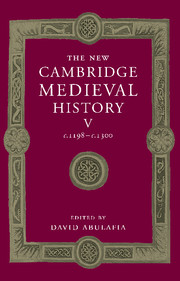Book contents
- Frontmatter
- Introduction
- Part I Common Themes
- 1 Social change in the thirteenth century
- 2 Commerce and communications
- 3 The vernacular
- 4 Art and architecture
- Part II The Church in the Thirteenth Century
- Part III The Western Kingdoms
- Part IV Italy
- Part V The Mediterranean Frontiers
- Part VI The Northern and Eastern Frontiers
- Appendix Genealogical tables
- Primary sources and secondary works arranged by chapter
- Index
- Plate section
- Map 1 Europe in the thirteenth century
- Map 3 France, c. 1260
- Map 5 Germany and the western empire
- Map 6 Genoa, Venice and the Mediterranean
- Map 8 The Latin empire of Constantinople and its neighbours
- Map 10 Aragon and Anjouin the Mediterranean">
- References
4 - Art and architecture
from Part I - Common Themes
Published online by Cambridge University Press: 28 March 2008
- Frontmatter
- Introduction
- Part I Common Themes
- 1 Social change in the thirteenth century
- 2 Commerce and communications
- 3 The vernacular
- 4 Art and architecture
- Part II The Church in the Thirteenth Century
- Part III The Western Kingdoms
- Part IV Italy
- Part V The Mediterranean Frontiers
- Part VI The Northern and Eastern Frontiers
- Appendix Genealogical tables
- Primary sources and secondary works arranged by chapter
- Index
- Plate section
- Map 1 Europe in the thirteenth century
- Map 3 France, c. 1260
- Map 5 Germany and the western empire
- Map 6 Genoa, Venice and the Mediterranean
- Map 8 The Latin empire of Constantinople and its neighbours
- Map 10 Aragon and Anjouin the Mediterranean">
- References
Summary
THE visual culture of thirteenth-century western Europe saw the refinement and spread of the Gothic style throughout much of north-west Europe, and in this sense it consolidated and extended the substantial achievements of the twelfth. But while the dominant currents of patronage and thought in the twelfth century can be traced primarily in the sphere of reformed monasticism, by 1200 creative initiative was passing increasingly into the hands of the cathedrals, the cities and the lay aristocracy. This new pattern of initiative reflected the strengthening and centralisation of secular power, especially monarchy, the immense power of cathedral chapters especially in northern Europe, and the increasing momentum lent to patronage of all types by expanding urban economies. As a result, some of the outstanding creative accomplishments of the century of Innocent III and Boniface VIII can be ascribed to a new urban milieu; one line of thought on the Gothic style has seen it as essentially both royal and urban in inspiration. Nevertheless, clerical, and especially episcopal, patronage remained absolutely central, and we are fully entitled to see the main symbol of the creative energies of the century, the Gothic cathedral, as a sign of the triumphalist mood of a newly militant universalising Church.
Some authorities have chosen to see the major developments of the century most especially in the light of the relatively new sphere of royal court patronage, dominated by Paris. To an extent this is justified. By 1200 Paris had already seen major innovations in visual, intellectual and musical culture which arguably rendered it the most dynamic artistic centre in northern Europe at a time when previously seminal cities, notably Rome and Constantinople, were witnessing a period of stagnation or decline.
Keywords
- Type
- Chapter
- Information
- The New Cambridge Medieval History , pp. 84 - 106Publisher: Cambridge University PressPrint publication year: 1999

